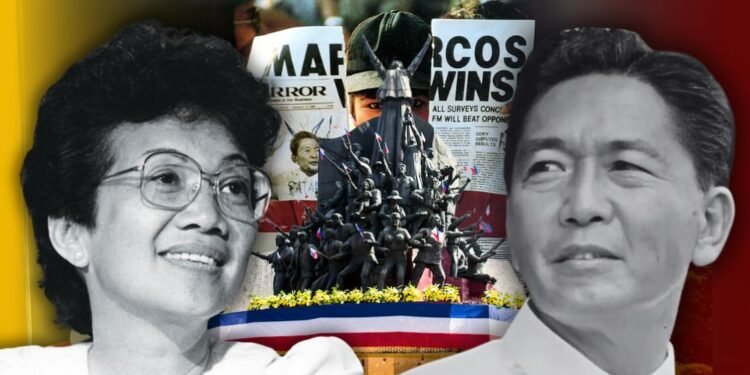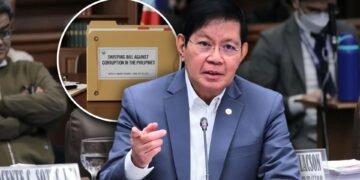Today, we once again commemorate the 1986 People Power Revolution, a historic moment when millions of Filipinos took to the streets to demand change. Nearly four decades later, the Philippines has deepened its security ties with the United States amid rising tensions in the West Philippine Sea.
Domestically, the upcoming midterm elections will determine not just the balance of power in the Senate and House but also whether Vice President Sara Duterte will be impeached—an outcome that could extinguish the spark in the Duterte brand and reshape the presidential race in 2028.
Economic concerns, from inflation to foreign investment strategies, weigh heavily on governance, while debates over sovereignty and foreign influence remain as relevant as ever.
The People Power narrative endures, but its meaning is contested, particularly in the context of how much control Filipinos truly have over their country’s political and economic future.
Understanding the current political state requires the same depth of analysis as understanding EDSA—looking beyond the revolution itself and examining the broader forces that shaped its outcome, forces that continue to influence the Philippines today.
The Political Landscape of EDSA: Global Forces and Shifting Alliances
To understand this, it is important to look beyond the moment itself and examine the broader political and geopolitical context of the time.
While the revolution was driven by widespread public frustration with the Marcos regime, it unfolded against the backdrop of shifting global alliances, Cold War politics, and changing priorities in Washington.
The Philippines had long been a key strategic outpost for the United States, and Marcos’ leadership had been tolerated—if not outright supported—because he aligned with American interests.
However, by the early 1980s, this relationship began to change, which makes one question whether the fall of Marcos was purely the result of internal dissent or if international factors played a significant role.
While the People Power Revolution was a genuine outpouring of public discontent, some historical accounts suggest that foreign forces—particularly the United States—played a more active role in shaping its outcome than is widely acknowledged.
For decades, Washington had been a strong backer of Ferdinand Marcos, Sr., largely due to his role in countering communism and maintaining U.S. military bases in the Philippines.
The U.S. provided him with billions in military and economic aid, tolerated human rights abuses, and relied on the Philippines as a key strategic outpost.
What many do not realize is that in the years leading up to the People Power Revolution, Marcos was quietly attempting to move away from complete U.S. dependence.
He explored alternative alliances—a move that likely contributed to Washington’s decision to withdraw support from him.
By 1975, Marcos had become the first Southeast Asian leader to establish diplomatic relations with Communist China, a bold step during the Cold War. While the U.S. was cautiously opening relations with Beijing, Washington still viewed China as a potential threat.
Marcos saw economic cooperation with China as a way to diversify the Philippines’ foreign relations and reduce dependence on the United States.
Marcos’ Shift Away from U.S. Influence: Dangerous Alliances and Growing Tensions
China was not the only country Marcos engaged with. By the early 1980s, he was in talks with the Soviet Union, which was eager to expand its influence in Southeast Asia.
Trade agreements and economic partnerships were under discussion, and Marcos saw this as an opportunity to gain additional leverage against the U.S. If the Philippines could establish deals with Moscow, it would no longer be entirely reliant on American support.
However, Washington saw this as a dangerous shift. The Philippines had long been a key military outpost for the U.S., and Marcos’ willingness to engage with the Cold War rival of the United States was a red flag.
Marcos also opened diplomatic channels with Libya under Muammar Gaddafi, a country accused of funding Muslim separatist groups in Mindanao.
Instead of escalating military confrontations, Marcos sought direct negotiations with Libya to broker peace with the Moro National Liberation Front (MNLF), an approach that the U.S. viewed with suspicion.
To Washington, Marcos was no longer the loyal Cold War ally he once was—he was now a leader trying to play multiple sides to his advantage.
The CIA’s Alleged Role in Marcos’ Fall and U.S. Intervention
As EDSA reached its peak, Marcos initially refused to step down, considering a counteroffensive using loyal military forces. However, before he could act, Washington intervened.
The U.S. Air Force transported Marcos and his family out of the Philippines—not to Ilocos, not to Paoay, but straight to Hawaii. This move effectively ended any chances of Marcos rallying his loyalists for a return to power.
This was no mere humanitarian intervention; it was a calculated step to prevent Marcos from launching a resistance.
The transition of power had to be smooth to maintain stability in the Philippines—not necessarily for the benefit of Filipinos, but to ensure that U.S. strategic interests, particularly its military presence, remained intact.
The Philippines and Its Continuing Struggle for True Sovereignty
None of this is to say that EDSA was not real. The millions of Filipinos who took to the streets, who risked their lives, who demanded change—they were real. Their courage was real.
Their anger was real. But so too was the role of the United States in shaping the outcome. The EDSA Revolution, while genuine, also aligned perfectly with U.S. geopolitical objectives.
Marcos had to go, but the system that kept the Philippines under U.S. influence remained intact. The U.S. military bases stayed. Economic policies remained tied to Western interests.
The Philippines continued to follow Washington’s lead in foreign policy. The revolution removed a dictator, but it did not dismantle the structures that allowed external forces to dictate the country’s fate.
Perhaps the greatest betrayal of EDSA is that, after all the blood, sweat, and sacrifice, the Filipino people were never truly given full control of their destiny. We cheered for democracy, but did we ever demand sovereignty?
We fought for change, but did we ensure that it was the Filipino people—not foreign powers, not political elites—who shaped what came after?
Freedom was promised at EDSA in 1986, but sovereignty never came.
Marcos Jr.: A Return to U.S. Ties and the Fight for Sovereignty
Decades later, the struggle for true sovereignty continues. But in a historical irony, it is now Ferdinand Marcos Jr. who has fully embraced alignment with the United States—the very power that helped remove his father.
In stark contrast to his father’s strategy of balancing relationships with multiple global players, Marcos Jr. has doubled down on strengthening U.S. ties, expanding military cooperation through the Enhanced Defense Cooperation Agreement (EDCA) and granting the U.S. access to additional military bases.
His administration has also taken a harder stance against China, positioning the Philippines more firmly in Washington’s geopolitical orbit.
The Philippines: A Strong Alliance, Yet Weak Defense
Nearly four decades after the 1986 EDSA Revolution, the Philippines remains tied to the United States yet has one of the weakest militaries in the region.
The government celebrates continued U.S. military aid despite Trump’s freeze on foreign assistance, yet decades of dependence have not built a military capable of defending the nation.
This reliance extends beyond defense. Millions of Filipinos seek opportunities abroad—often illegally—because their own country fails to provide for them.
While the government praises its alliance with the U.S., the same country forces undocumented Filipinos into hiding. The cycle of dependence keeps the nation weak, forcing its people to look elsewhere for survival.
Foreign powers still dictate the country’s fate—whether in the battle for the West Philippine Sea, economic policies that leave Filipinos struggling, or political maneuvering ahead of the next election.
These lingering problems create a cycle of instability, conditioning Filipinos to repeatedly take to the streets in protest, as if constant upheaval is the goal. When a nation is kept in a state of unrest, the focus remains on immediate change rather than long-term sovereignty.
The True Lesson of EDSA: Reclaiming Control of the Future
The fight for sovereignty is not waged in a single uprising but in the policies we uphold, the leaders we choose, and the principles we defend. The true lesson of EDSA is not just about removing tyrants but about reclaiming the right to determine our future, unchained from external influence.
Until the Philippines can chart its own course without interference, the revolution remains unfinished.
The streets of EDSA proved that the Filipino people could rise, but true freedom will only come when we no longer have to.












